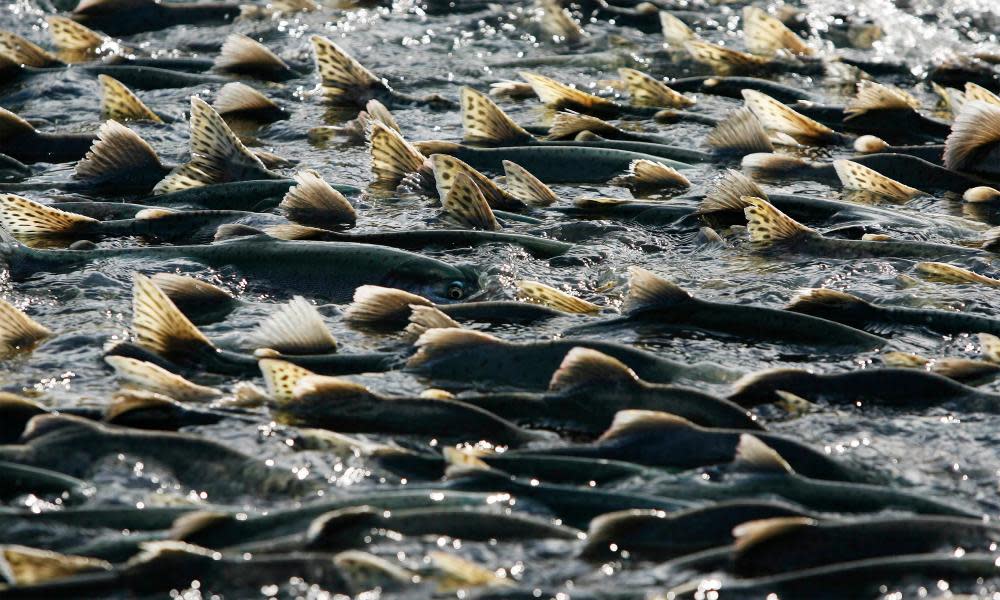Greed is killing Alaska's salmon habitat – but we can still save it

When John Muir wanted to prove his theory that glaciers had carved his beloved Yosemite Valley, he sailed north to Alaska and found rivers of ice so massive they flowed from tall coastal mountains all the way to the sea.
He also found Pacific salmon, a lifeblood, five species of remarkable fish that leave their natal rivers and streams, go out to sea for two to five years, and return to freshwater to spawn and die. The indigenous Tlingit who paddled Muir hundreds of miles in their cedar dugout canoes taught the California naturalist much about gratitude, and what it means to live among salmon, free of money.
I, too, learned this when I arrived as a new park ranger in 1979, the centennial of Muir’s first visit. The bush pilot who landed me next to Glacier Bay said: “Welcome to Alaska. You can set your watch back 100 years.”
The glaciers thrilled me; the wild salmon inspired me. How they flashed and fought their way across forest-fringed bays and back upstream through a gauntlet of fishermen, eagles, wolves and bears, the cycle of life never ending, never dull. And how, when cooked just right, the fillets melted in my mouth. I wondered then as I do today: how could anything so precious ever be put in jeopardy?
Easy. Money. “Nothing dollarable is safe,” Muir would write after witnessing the ravages wrought by California’s loggers and Alaska’s gold stampeders. Rapacious men in what he called the “gobble, gobble school of economics”. Men who would later overfish Alaska’s wild salmon, in the early 1900s.
The salmon slowly recovered, only to face a suite of new problems today: warmer seas, increasing amounts of micro-plastics and other pollutants, ocean acidification, and most critical of all – habitat destruction from coastal and streamside development.
The Alaska department of fish and game’s sport and commercial fishing regulations contain hundreds of pages that specify how, where and when fish may be caught, how many fish may be retained, and so on. But the regulations devote only one page about protecting onshore salmon habitat: the rivers, streams and lakes, and their forested fringes, that give rise to every new generation of prized fish.
That needs to change, and soon might. One of the largest grassroots campaigns in the history of Alaska has placed on the November ballot a Stand for Salmon initiative set to expand habitat protections. “Of course our changing ocean is affecting our salmon,” writes Bob Shavelson, one of the initiative’s sponsors. “But when we look at the demise of salmon from Europe to New England to the Pacific north-west, we know one thing is 100% true: wild salmon need healthy coastal habitat. Period.”
While fishing employs more people in Alaska than any other industry, big oil generates much more money. It’s the Goliath that opposes Stand for Salmon with its own motto, Stand for Alaska, as if protecting salmon habitat were somehow anti-Alaskan.
Financed by ConocoPhillips, British Petroleum, the Pebble Partnership and others, Stand for Alaska has raised $10m and hired DCI, the same public relations firm that fought against smoking regulation. How? By creating doubt and fear with shticks like: they want to take away your cigarettes. What’s next? Your hotdog? Your freedom?
These days in Alaska, any proposed coastal development gets easily approved. Big oil and mining like it that way, as does the governor and state legislature. Make the permitting process stricter, they say, and it will hamstring economic growth.
Meanwhile, the salmon runs of Alaska – among the last great ocean fisheries in the world – slowly decline.
“The big kings are gone,” a fisherman told me recently, speaking about the largest of five species. “The huge runs up the Stikine, Taku and Yukon rivers are gone. People say: ‘Oh, they’ll come back.’ Really? Are the fish going to fall out of the sky? No. They’re gone.”
Another fisherman told me that he believes all the wild salmon will disappear in his lifetime. “There’s no stopping it, unless something changes. There’s just too much industry and greed.”
There’s a saying among some Alaskans: “It takes a fish to feed a forest.” When bears pull wild salmon from the streams, and eat only a portion, the rest rots into the ground where roots pick up marine isotopes that can be found in the crowns of tall conifers, and in willows and birds.
“When we try to pick out anything by itself,” John Muir once wrote, “we find it hitched to everything else in the universe.”
Including us. We have a stake in this. Many of Alaska’s glaciers that inspired Muir are much smaller than they were in his time. The runs of wild salmon will be, too.
Unless something changes. In November.
Kim Heacox is the author of the biography, John Muir and the Ice That Started a Fire and the novel Jimmy Bluefeather, among other books

 Yahoo News
Yahoo News 
